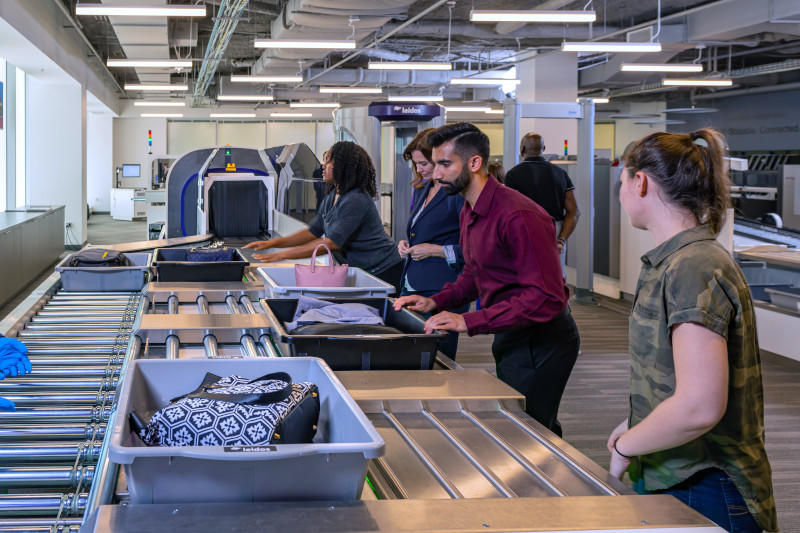Security doesn't sleep: The Leidos team behind airport security checkpoint installation
Most people have experienced busy airport security checkpoints, with steady streams of passengers moving through multiple lanes. What even seasoned travelers might not realize is that checkpoints can be even busier in the middle of the night.
That’s because it’s often late at night and into the early morning hours when the people who install checkpoint security equipment do their work. “Installing an entire checkpoint is a complex job and takes an experienced team of technicians working in a very coordinated way,” says Paul Mancinelli. “We help ensure it all happens without inconveniencing passengers, impacting safety, or interfering with airport operations.”
There aren’t many people who understand the challenge better than Mancinelli, who serves as a program manager for homeland solutions at Leidos, focusing on checkpoint security system integration for commercial customers. That makes him one of the leaders of a business that has a 22-year performance history on more than 10,000 checkpoint and baggage-security installations across 450 U.S. airports overseen by the Transportation Security Administration (TSA).
A growing need
With most airports expanding to keep pace with the growing demand for air travel, and with TSA upgrading security technology, the need to install new equipment, or to replace or move existing equipment, has been increasing as well. As part of a model public/private partnership, TSA can authorize an airport to contract directly with Leidos to get the new or modified checkpoints up and running.
That’s where Mancinelli’s group comes in. “We still have to meet all of the TSA’s requirements,” Mancinelli notes. “But we procure the equipment, oversee the installation, and take on the warranty, and we can do it all with the extra speed and flexibility to keep projects on schedule and within budget.” That flexibility stems not only from airport checkpoint experience, but also from the company’s best practices, established on large-scale logistics programs for the U.S. and U.K. militaries, for NASA, and for public health organizations.
RELATED READING: GLOBAL SUPPLY CHAIN INNOVATION in contested environments
The commercial market is relatively new and reflects the collaboration with government and industry. Mancinelli works directly with busy airport officials as they expand and upgrade security at checkpoints, in employee screening, and in checked baggage locations. The key to success, he emphasizes, is getting the job done while keeping the airport fully operational. That usually means the work has to be done at night, when there are no flights. “It’s a short window,” he explains.
These projects involve several complex steps, including equipment installation, testing, and site restoration. Quality execution requires collaboration with dozens of specialists from Leidos, the airport, and multiple original equipment manufacturers, or OEMs. “A lot of planning goes into those nights to ensure it goes smoothly,” he says.
Pre-installation tasks include site surveys, concept design, issued-for-construction drawings, permit approvals, and site preparation. They also involve meshing the schedules of all the needed specialists, ensuring the right equipment and parts are on hand, coordinating with the airport, and ensuring TSA is on board with the work. After equipment is installed, operational readiness testing, system acceptance testing, site restoration, and as-built designs must also be completed.
Jumping in
Despite the careful planning, there can be last minute changes. “I’m always ready for that 2 a.m. phone call about an issue that can come up,” says Mancinelli. “But we strive to make it all work, helping to ensure the checkpoint is up and running by morning before passengers arrive, and that is where experience matters.”
Leidos stands behind this work, offering a full life-cycle service, providing preventive and corrective maintenance in support of safe and efficient operations well into the future.
Additionally, the holiday travel season often calls for airports to expand checkpoints to serve the influx of travelers. “We know how important these jobs are for the airport’s mission and for the traveling public, so we roll up our sleeves and jump in,” Mancinelli adds.
RELATED READING: TSA’S TOP TRAVEL TIPS
Focusing on the airports’ mission—keeping air travel as smooth, frictionless, and as safe as possible—has earned Leidos a lot of good will, says Mancinelli. “We get a lot of positive feedback and repeat business,” he notes. “There are many opportunities in this market, but it’s a commitment to providing the best value that allows us to partner with our customers to successfully perform this work.”
Passengers may never know it, but it’s that commitment that also gets them through the airport and to the gates in time for their flights. Even if the real work happened while they were still asleep.




